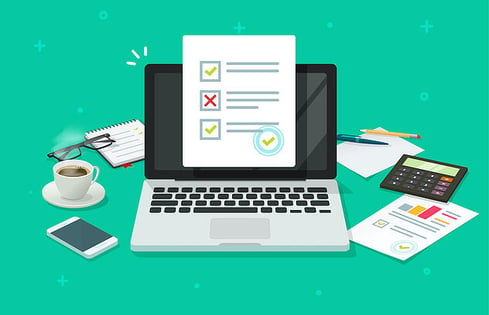How to Conduct a Training Needs Assessment

What is a Training Needs Assessment (TNA)?
Today’s workplace is fast-paced and demanding. Not everybody is willing to invest time in conducting a needs assessment; however, the practice is critical for enhancing workplace performance. Many businesses make assumptions of what their training needs are and how to conduct a training needs assessment.
This can have a significant impact on the success of training efforts because actions may address a symptom but not the real problem to be solved.
A workforce TNA is a way to collect information and to analyze the depth and scope of a problem. Assessments of a problem don’t have to belong or be intensive. If the issue is the rollout or change of a system or new job, the TNA can be reasonably quick. If there is evidence of a problem but no defined solution, or previous solutions have not presented satisfactory results, a longer look at other systemic factors may be required.
Do you require a Training Needs Assessment?
The short answer to this question is most likely yes!
The key to identifying and implementing an issue-free solution is to know the problem before it becomes an issue. Even if you think you know the issue you are planning training for, a TNA can identify other issues, and ensure you answer them. It doesn’t mean that you should address the entire problem as this may be out of scope for your area or the organization’s need.
However, without an assessment, there is a risk of going in the wrong direction without validating assumptions. Program development can go in the wrong direction, waste time, and include significant costs due to rework or repositioning.
The following are several things to consider on how to conduct a training needs assessment:
-
What seems to be the problem?
-
Why is this an issue now?
-
What is the ideal solution you are looking for in terms of ‘success factors’ for the problem?
The answers to these questions should lead you to come to some conclusions:
-
Type of issue being presented
-
Age of issue
-
New and you can’t solve it with what you have available to you
-
You can solve it but would like expert assistance
-
You don’t know and need help
-
Solution sought (at least in this moment)
The TNA Process - Project Phases
Phase 1: Scoping Exercise to gather preliminary data about the needs
Phase 2: Planning Approach for performing the needs assessment
Phase 3: Data Gathering To collect knowledge and skill requirements
Phase 4: Gap Analysis Mapping of learning requirements. Analyze the data
Phase 5: Report Preparation Training Strategy Document
Phase 6: Presentation of Findings Executive Summary Format
Phase 1 – Scoping
The first step in how to conduct a training needs assessment is to gather preliminary and relevant data about the training needs of the target learners.
Phase 1 objectives:
-
Establish goals
-
Determine whether and how the lack of knowledge and skills affect the training needs
The following answers are required in this phase, which you have already determined using the tool above:
-
What is the problem and how does it link to business measures or requirements?
-
What is the desired outcome for the solution?
-
What resources are already on hand and available for analysis?
-
What is the risk involved in the business?
This is also the right time to start thinking about the following as it pertains to your issue and organization:
-
What motivation must the organization and the employees (separately) come to better perform because of the problem being solved?
-
What incentive do employees and management have in solving or reducing this problem?
-
What skills, knowledge, and information gap or awareness is already apparent within the organization regarding this problem?
-
Does the employee have the right environment, tools, and processes to successfully complete their work?
-
Does the employee feel that they are contributing to the overall organizational goals?
Phase 2 – Planning the Training Needs Assessment
The next step is to develop a working plan to ensure that the assessment stays on target.
Phase 2 objectives:
-
Determine what types of data may be collected
-
Determine sources of data
-
Examine the purpose of assessing the knowledge and skills
-
Confirm the types of analysis that need to be performed
-
Identify the methods to collect data
Determine sources of data
In the previous phase, we determined what information is present and what needs to be gathered. This sets the stage for the data collection efforts in Phase 2.
Identify the methods to collect data
The next activity is to determine the method for collecting the required data. The final decision will depend on the information required, the source contact, and the timeline.
The following six methods of data collection are the most efficient and effective to use in a Needs Assessment. Using more than one method enhances the reliability of data.
-
Online surveys
-
Focus groups
-
Best practices literature searches
-
Job mapping
-
Observations
-
One-on-one interviews
Phase 3 – Data Gathering
Gathering relevant data helps determine the performance gap, the difference between “what is” and “what should be”. A thorough knowledge and skills assessment help in defining this gap by identifying the deficiencies.
Phase 3 Objectives:
-
Develop assessment tools
-
Collect assessment data
Develop the assessment tools
After determining the information required and the methods to collect it, the next step is to develop the tools.
Online surveys
Online surveys include questions regarding the information that needs to be collected. Most questions are closed, some may be open-ended. Closed response questions list a fixed set of alternatives, like multiple-choice questions.
Electronic focus groups
Electronic focus groups use interview guides to ensure the reliability of responses across different groups. The questions asked here are like the ones asked in online surveys, although more open-ended questions are preferred to allow further probing.
Best practices literature search
Best practices literature searches involve researching how other organizations have solved their performance-related issues. Other organizations may or may not belong to the same industry.
Job mapping
Job mapping involves discovering and recording the tasks involved in doing a job in order to identify knowledge, skills, expected performance, and barriers to doing the job.
Observations
The Observation Worksheet is used to document data gathered in an unstructured observation, for example, while observing employees to understand what their jobs involve on a regular basis, or while seeking to classify differences between two jobs that are allegedly the same but are performed in different locations. methods.
Telephone interviews
Telephone interviews are a great way to elicit information from key stakeholders. An interview guide is important in getting the desired information. Telephone interviews allow flexibility in a global organization and can easily be administered.
Phase 4 – Gap Analysis
Phase 4 deals with analyzing and mapping the data collected and identifying the current situation. Once the current situation is known, it is compared with the expected outcome and identifies the performance gap. Then, a solution is recommended that will close the gap effectively.
Type of analyses
The three most common types of data analyses are content, process, and quantitative. The type of analysis chosen will depend on the kind of data being analyzed. Content analysis deals with analyzing qualitative data in a systematic, objective, and quantitative manner. It involves analyzing and classifying data into major content areas. Process analysis identifies the components or steps of a work process.
Phase 5 – Report Preparation
Phase 5 is where the needs assessment process, outcomes, and recommendations are documented. In this phase, all the steps are reviewed. This is the final phase of the needs analysis procedure and deals with creating a formal report. The report generally consists of elements like executive summary, goals, overview of data-collection methods, findings, and recommendations.
The report also contains budget constraints and alternative options to training execution wherever possible within the feasibility of all the recommendations offered. The key to performing a successful needs assessment is to be ready to adapt the strategy based on the requirement.
Phase 6 – Presentation of Findings
Phase 6 Objective: Present the research and discuss recommendations
Creating a summary of the findings and recommendations will help sponsors, stakeholders and the executive teams understand the approach, the data, and what the recommendations are. This includes identifying the next steps to take from the Training Needs Assessment; whether it is to start design or proceed with other recommended approaches.
Want to get started with Training Needs Assessment, but not sure where to begin?
Start with our 3 FREE Downloads!


